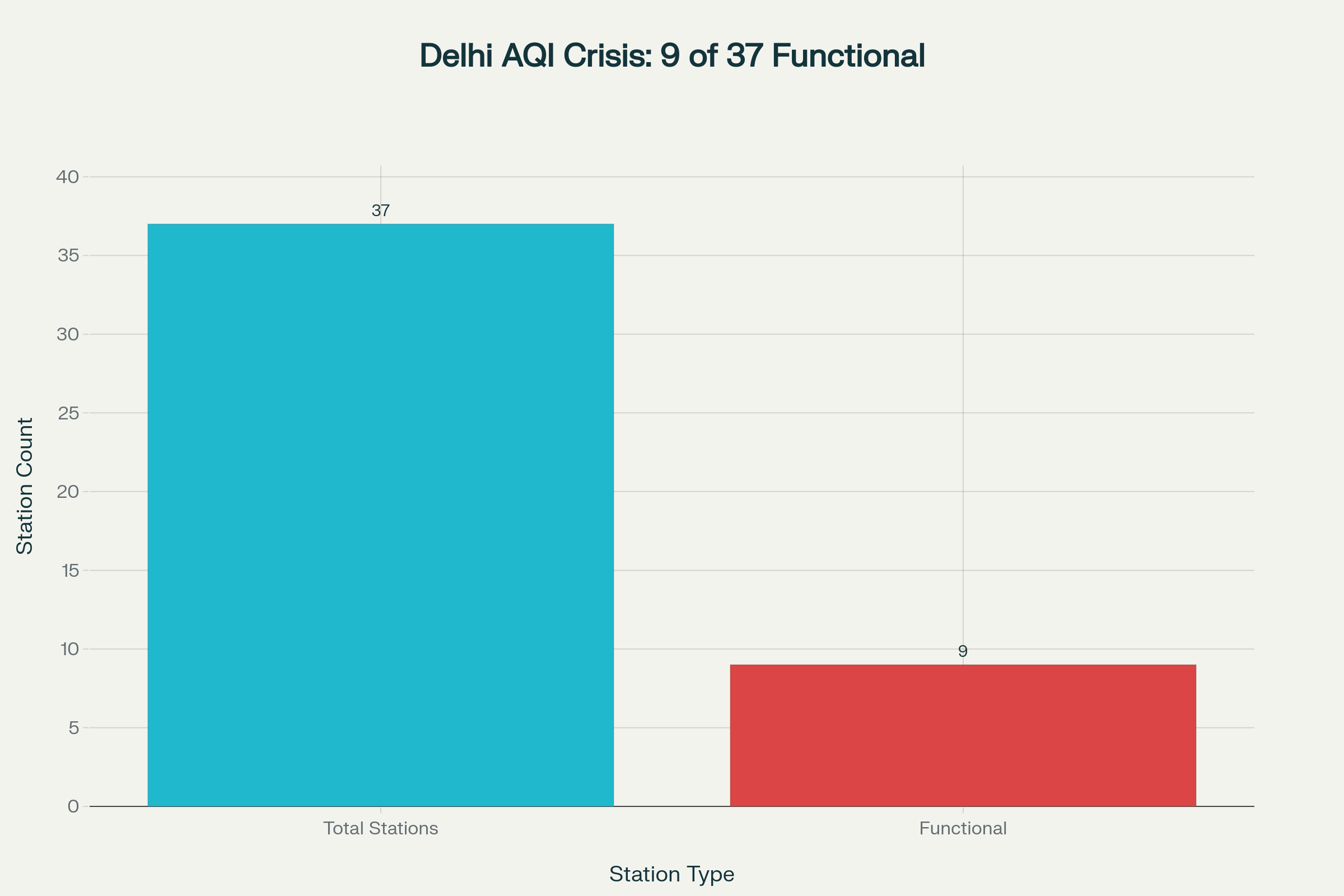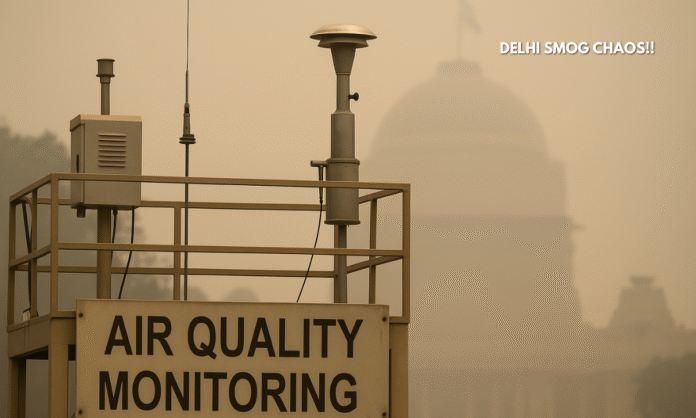Key Highlights
- Supreme Court reveals catastrophic failure in Delhi air quality monitoring infrastructure with only 9 of 37 stations operational during Diwali 2024
- Delhi AQI monitoring crisis undermines GRAP implementation effectiveness as CAQM lacks critical pollution data for decision-making
- Current Delhi air pollution levels reach 316 AQI with PM2.5 concentrations at 189.6 micrograms per cubic metre, far exceeding WHO safety limits
Opening Overview
Delhi air quality monitoring infrastructure faces its most severe crisis as the Supreme Court of India exposed shocking gaps in the city’s pollution tracking system during critical proceedings on November 3, 2025. The Delhi AQI monitoring crisis reached alarming proportions when it was revealed that only nine of the capital’s 37 air quality monitoring stations were functional during Diwali, precisely when the city needed comprehensive data to combat toxic pollution levels.
This Delhi AQI monitoring crisis has fundamentally compromised the Commission for Air Quality Management’s ability to implement the Graded Response Action Plan effectively, raising serious questions about the city’s capacity to protect its 32 million residents from hazardous air pollution. The Supreme Court’s intervention highlights how the Delhi AQI monitoring crisis extends beyond technical failures to represent a systemic breakdown in environmental governance, with PM2.5 levels reaching catastrophic heights of 488 micrograms per cubic metre during post-Diwali measurements.
Every November, Delhi holds its breath quite literally. This week, the Air Quality Index across the NCR breached 400 in several monitoring stations, sliding firmly into the “severe” category. The familiar haze has returned: grey skies, the acrid tang in the throat, children… pic.twitter.com/Hv41oam44g
— Sonik Sourabh (@SonikSourabh) November 3, 2025
Technical Infrastructure Breakdown Undermines Delhi’s Pollution Response
- Critical monitoring stations failed during peak pollution events when data accuracy becomes most essential for public health protection
- CAQM officials unable to determine proper GRAP implementation triggers due to insufficient real-time pollution data coverage across Delhi
The Delhi AQI monitoring crisis has exposed fundamental flaws in the city’s environmental surveillance infrastructure, with amicus curiae Aparjita Singh demanding accountability from the Commission for Air Quality Management regarding the monitoring station failures. The Delhi AQI monitoring crisis becomes particularly concerning when considering that the Central Pollution Control Board operates 37 monitoring stations across Delhi, yet 28 stations remained non-functional during the critical Diwali period when air pollution traditionally reaches its annual peak. This Delhi AQI monitoring crisis directly impacts the effectiveness of the Graded Response Action Plan, as CAQM cannot accurately determine when to implement Stage III or Stage IV measures without comprehensive pollution data from across the national capital region.
The technical aspects of the Delhi AQI monitoring crisis reveal systemic maintenance issues, with several stations reportedly suffering from equipment failures, power supply problems, and inadequate technical support during critical pollution episodes. Official data from the Central Pollution Control Board indicates that Delhi’s monitoring network should provide continuous coverage across 1,484 square kilometres, but the Delhi AQI monitoring crisis means vast areas lack reliable pollution measurements during emergency situations.

Delhi’s air quality monitoring infrastructure showed critical gaps during Diwali 2024, with only 9 out of 37 stations operational during peak pollution period
Supreme Court Intervention Demands Accountability for Monitoring Failures
- Justice BR Gavai’s bench orders CAQM and CPCB to submit detailed reports on air quality management capabilities and monitoring system effectiveness
- Court proceedings highlight how missing pollution data compromises constitutional duty to provide pollution-free environment for citizens
The Supreme Court’s intervention in the Delhi AQI monitoring crisis represents unprecedented judicial scrutiny of environmental monitoring capabilities, with the bench led by outgoing Chief Justice BR Gavai directing both CAQM and CPCB to file comprehensive reports on their air quality management efforts. The Delhi AQI monitoring crisis prompted sharp questioning from the court, with amicus curiae Singh emphasising that “we don’t even know when to implement GRAP” due to the severe shortage of functional monitoring equipment during critical pollution periods.
Legal proceedings surrounding the Delhi AQI monitoring crisis have revealed that the Supreme Court previously directed CAQM to alter GRAP implementation thresholds in December 2024, yet the monitoring infrastructure remains inadequate to support these revised protocols. The Delhi AQI monitoring crisis has become central to ongoing litigation concerning Delhi’s air pollution management, with the court noting constitutional obligations of both central and state governments to ensure pollution-free environments for citizens. Recent Supreme Court orders demonstrate growing judicial impatience with the Delhi AQI monitoring crisis, particularly after the court mandated that GRAP Stage IV restrictions must continue even if AQI falls below 450, requiring accurate monitoring data that the current system cannot reliably provide.
Health Impact Analysis: Pollution Levels Exceed WHO Standards by Massive Margins
- PM2.5 concentrations reach 189.6 micrograms per cubic metre, nearly 13 times WHO’s annual guideline limit of 15 micrograms per cubic metre
- Current pollution levels pose severe health risks to vulnerable populations including children and elderly residents across Delhi-NCR region
The Delhi AQI monitoring crisis coincides with alarming pollution measurements that demonstrate the urgent need for comprehensive environmental surveillance across the national capital region. Current PM2.5 readings of 189.6 micrograms per cubic metre represent levels that are 12.6 times higher than World Health Organization annual guidelines of 15 micrograms per cubic metre, while PM10 concentrations at 316 micrograms per cubic metre exceed WHO recommendations by even greater margins.
The Delhi AQI monitoring crisis becomes more critical when considering that WHO guidelines specify annual average PM2.5 concentrations should not exceed 5 micrograms per cubic metre, making current Delhi pollution levels approximately 38 times higher than optimal health standards. Research data indicates that Delhi residents experience PM2.5 exposure levels up to 30 times WHO safety limits during severe pollution episodes, with the Delhi AQI monitoring crisis preventing accurate assessment of population exposure across different neighbourhoods. The health implications of the Delhi AQI monitoring crisis extend beyond immediate respiratory effects, with long-term PM2.5 exposure linked to cardiovascular disease, lung cancer, and premature mortality rates that could affect millions of Delhi residents annually.
| Pollutant | Current Delhi Level | WHO Annual Guideline | Exceedance Factor |
|---|---|---|---|
| PM2.5 | 189.6 µg/m³ | 15 µg/m³ | 12.6x higher |
| PM10 | 316 µg/m³ | 45 µg/m³ | 7.0x higher |
| Overall AQI | 316 (Very Poor) | Good (<50) | 6.3x higher |
GRAP Implementation Challenges Amid Monitoring Infrastructure Crisis
- CAQM unable to accurately determine Stage III and Stage IV GRAP triggers without reliable real-time pollution data from functional monitoring stations
- Current monitoring gaps prevent effective assessment of pollution control measure effectiveness across Delhi-NCR region
The Delhi AQI monitoring crisis has severely compromised the Commission for Air Quality Management’s ability to implement the Graded Response Action Plan effectively, with CAQM officials unable to access comprehensive pollution data during critical decision-making periods. The Delhi AQI monitoring crisis directly impacts GRAP Stage implementation protocols, as the system requires AQI readings above 350 to trigger Stage III measures and readings above 400 for Stage IV restrictions, but non-functional monitoring stations prevent accurate assessment of city-wide pollution levels.
Recent GRAP orders demonstrate how the Delhi AQI monitoring crisis affects policy implementation, with CAQM invoking Stage II measures on October 19, 2025, when AQI reached 301-400 levels, yet insufficient monitoring coverage raises questions about data accuracy across Delhi’s diverse geographical areas.
The Delhi AQI monitoring crisis becomes particularly problematic for GRAP enforcement, as construction activity restrictions, vehicle movement limitations, and industrial operation controls require precise pollution measurements to assess compliance and effectiveness across different Delhi districts. Official CAQM documentation reveals that the Delhi AQI monitoring crisis undermines the commission’s mandate to provide science-based air quality management, as the statutory body requires comprehensive monitoring data to coordinate pollution control measures across NCR states.
Closing Assessment
The Delhi AQI monitoring crisis exposed by Supreme Court proceedings on November 3, 2025, represents a fundamental failure of environmental governance that extends far beyond technical equipment malfunctions to reveal systemic inadequacies in India’s pollution management infrastructure. The revelation that only nine of Delhi’s 37 monitoring stations functioned during Diwali highlights how the Delhi AQI monitoring crisis undermines the constitutional obligation to provide citizens with pollution-free environments, particularly when PM2.5 levels reached 488 micrograms per cubic metre during critical pollution episodes.
The Supreme Court’s demand for comprehensive reports from CAQM and CPCB signals that the Delhi AQI monitoring crisis will likely trigger significant reforms in environmental monitoring protocols, potentially leading to enhanced technical infrastructure and improved maintenance standards across Delhi-NCR’s pollution surveillance network. As Delhi continues to rank among the world’s most polluted cities, the Delhi AQI monitoring crisis serves as a stark reminder that effective environmental protection requires robust technical systems capable of providing accurate, real-time data during the precise moments when public health protection becomes most critical.


